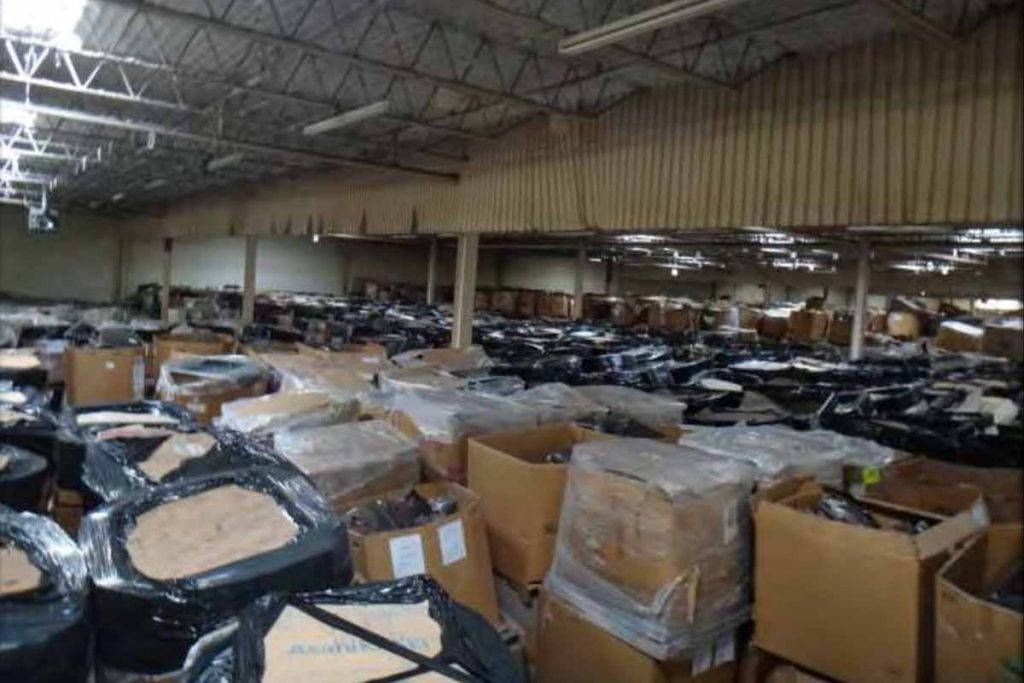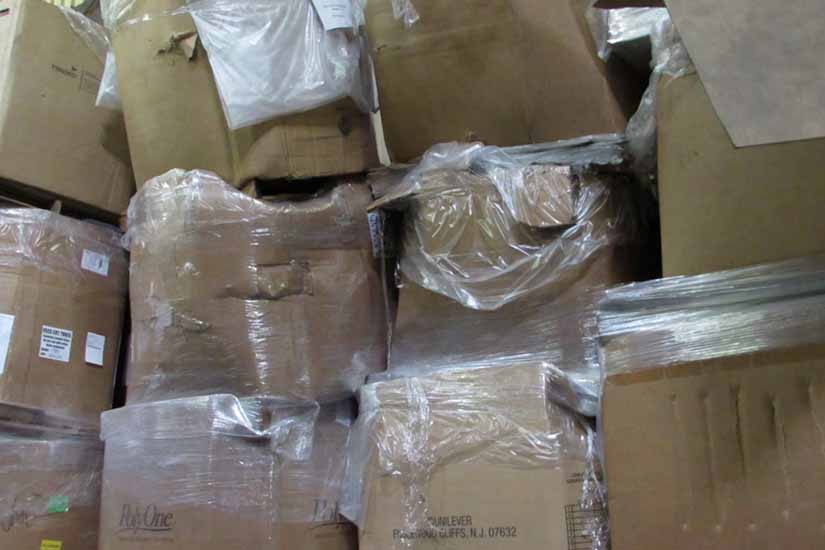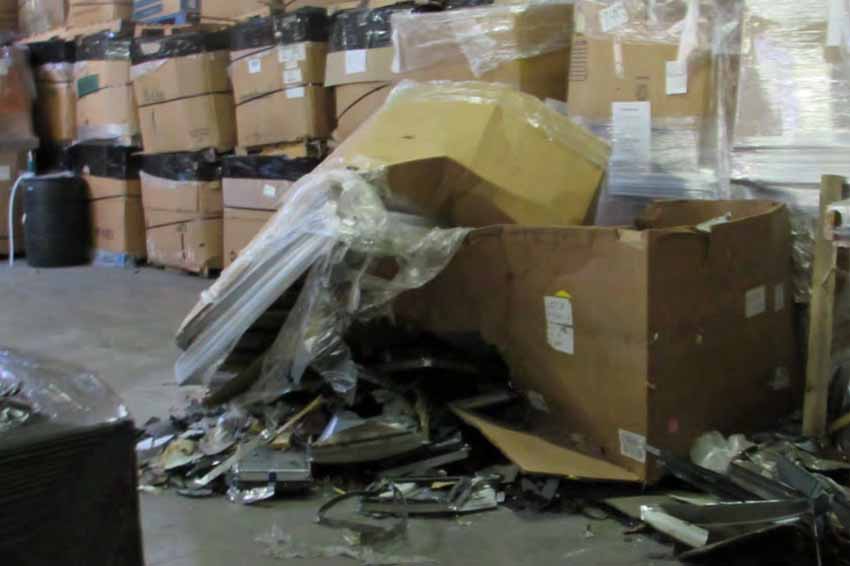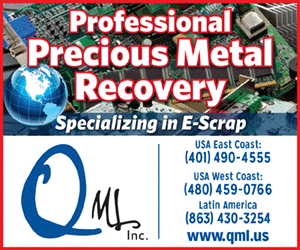
An overview of the abandoned material at the former Closed Loop facility on Fairwood Avenue in Columbus, Ohio. | Courtesy of DEC Enviro
Consultants estimate that recycling 30 million pounds of CRT glass at an Ohio warehouse would add $1.7 million to a $5 million cleanup bill, so they’re proposing to landfill the glass instead.
EnSafe recently released a cleanup plan for nearly 131,000 square feet of warehouse space formerly leased by Closed Loop Refining and Recovery. The warehouse, at 2200 Fairwood Ave. in southeast Columbus, Ohio, is owned by real estate owner and manager Olymbec USA.
Closed Loop failed in early 2016, leaving behind stockpiles of CRT glass totaling hundreds of millions of pounds in Arizona and Ohio.
In Ohio, property investment company Garrison Southfield Park owns two warehouses along Watkins Road that hold 128 million pounds of CRT materials. Less than two miles away, on Fairwood Avenue, sits the Olymbec USA warehouse with about 30 million pounds. Both landowners have sued over 40 former suppliers of CRTs to Closed Loop, and two dozen settlements have been reached.
In April, EnSafe, a consulting firm working for both landowners, submitted a cleanup plan to the Ohio EPA for the Watkins Road warehouses. The firm posted the May 2020 cleanup plan for Fairwood Avenue in the last few weeks.
“Olymbec USA LLC is looking forward to achieving the goals of the cleanup plan that has been subjected to public notice and comment,” according to a statement from the company to E-Scrap News. “Olymbec USA LLC and its representatives have worked diligently and cooperatively with the Ohio Environmental Protection Agency to develop a plan that is sufficiently protective of human health and the environment and that can be implemented in an efficient and cost effective manner.”
Cost complications from condition of material
Closed Loop Refining and Recovery started leasing space at 2200 Fairwood Ave. in December 2014. Today, about 90% of the space is taken up by boxes of CRT devices and CRT glass. The boxes were stacked an average of three high, with some of them having collapsed to the floor or against the inside side of the structure.
A 2019 consultants’ report estimated the warehouse held 30.9 million pounds of material, made up of the following: 22.6 million pounds of unprocessed CRTs, 7.4 million pounds of crushed CRT glass and over 900,000 pounds of crushed CRT screens and other components.
The plan makes clear the glass at Fairwood Avenue is likely destined for landfill, because of the way Closed Loop handled it. That’s also the case for most of what’s in storage at the Watkins Road sites.
“As currently proposed, processed and non-processed CRT units and other e-waste materials stored in the Fairwood Avenue warehouse will be disposed as RCRA hazardous waste and will not be recycled under the [Resource Conservation and Recovery Act] CRT conditional exclusion and Ohio state corollaries,” the plan states.
That decision is based on the fact that recycling the material instead of landfilling it would add 5.5 cents per pound in costs, amounting to a total project cost increase of $1.7 million, or 35%. The higher cost is due to unprocessed CRTs having already been stripped of their valuable metals and the processed glass being a mix of funnel and panel glass, which means higher lead smelting costs, the plan states.
“In the event that whole CRT units are identified during removal action activities, then whole CRT units may be recycled,” according to the plan.

Dangerously stacked material in the former Closed Loop facility. | Courtesy of EnSafe.
CRT processors submit bids
As is the case with EnSafe’s cleanup plan for the Watkins Road properties, the Fairwood Avenue calls for a multi-phased approach.
In the first step, crews will create contamination-reduction and clean-loading zones, through which they’ll move boxes of material for loading into trailers. Then, they’ll remove all materials. This second phase will involve cleaning leaded dust off of material, repacking material if necessary, and weighing, labeling and loading it in a truck trailer. Lastly, crews will decontaminate the building.
The plan estimates materials removal costs at $3.73 million, decontamination at $479,000, site preparation and lead abatement at $475,000, and project management and oversight at $372,000, for a total project cost of $5.06 million. That sum doesn’t count about $109,000 Olymbec has spent to date on consultants and removal of hydrofluoric acid and glass washing sludge, according to the plan.
For materials removal, specifically, the documents estimate the cost to remove non-processed CRTs at 12.50 cents per pound and crushed CRT glass as 10.55 cents per pound. The May 2020 plan notes that three companies recently submitted bids to clean out material: Novotec, Hepaco and URT. The plan documents indicate that a contractor hasn’t been formally selected yet.
For the Watkins Road warehouses, Garrison Southfield Park inked a deal with Novotec, which is based in Columbus. Novotec could be paid up to $14 million to clean out the Watkins Road sites, charging 22 cents per pound for whole units, 14 cents per pound for unprocessed CRTs and 10.25 cents per pound for mixed, crushed funnel and panel glass in gaylords.
A February 2019 report from a different consulting firm, DEC Enviro, identified two other companies that had previously submitted quotes for removing materials from Olymbec USA’s warehouse: Kuusakoski and MAX Environmental.
DEC Enviro noted Kuusakoski and its related companies originally shipped to Closed Loop as much as 40% of the material at the Ohio facilities. It said MAX Environmental operates a landfill in Yukon, Pa. where it’s permitted to treat and dispose of hazardous waste. It operates one of three landfills where Novotec proposed to dispose of material cleaned out of the Watkins Road warehouses.
Neither Kuusakoski nor MAX Environmental were identified as current bidders in the May 2020 cleanup documents.

Spilled CRT material inside the former Closed Loop facility. | Courtesy of EnSafe.
Building decontamination required
As is the case with the Watkins Road facilities, EnSafe’s plan calls for the building to be decontaminated after CRT materials are removed. That’s because there’s lead dust inside.
In July 2017, EnSafe studied the lead contamination in dust inside the space by analyzing wipe samples. Lab analyses found a range from as low as 59 micrograms of lead per 100 square centimeters of surface to as high as 760 micrograms per 100 square centimeters. According to the report, the Brookhaven National Laboratory set acceptable surface levels at 40 micrograms.
For site preparation, lead abatement and decontamination work, bids were submitted by Hepaco, Aztec, Enviroserve and HEPA. As is the case with the material removal contractors, the May 2020 plan states a decontamination contractor has not yet been formally selected.
So far, only a limited amount of cleanup has occurred at Olymbec USA’s facility.
In July 2017, crews removed hydrofluoric acid and lead-bearing sludge that was being stored inside. The materials were byproducts of a glass-washing process that had taken place there. According to EnSafe’s cleanup plan, Closed Loop halted the glass washing in summer 2015 after some processing equipment broke.
The full cleanup could take up to three years, the documents estimate. Materials removal itself could take over two years. Decontamination of the building could take another seven to eight months. And preparation of closure documentation could take another two months.
More stories about CRTs
- Analysis: CA climate rules set off ripple effect for thousands
- URT closes New Hampshire site, shifts work west
- Closed Loop companies hit with $3 million in Ohio penalties



